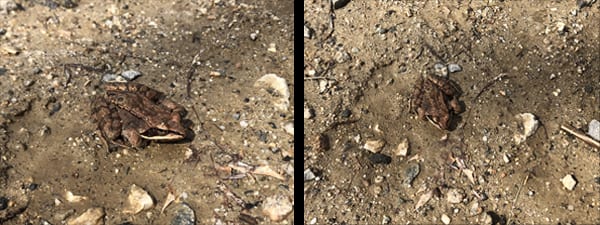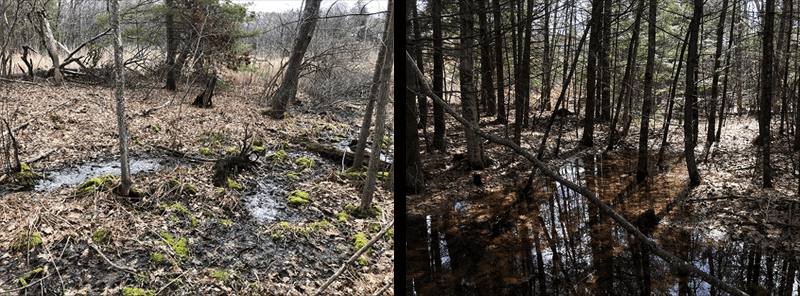
What amphibians can be seen and heard this time of year? Where can they be found? How does their life cycle begin?
This fun video by Nat Wheelwright introduces us to the timeline of frogs calling and breeding in Maine, starting with the Wood Frogs and Spring Peepers that are currently out and about in our small ponds and vernal pools.
Toward the end of the video, Nat shared many of the amazing sounds frogs make to communicate with one another. Visit the website below to start learning which frogs make which sounds….the second link will bring you to a quiz to test your knowledge!
Frog Call Challenge
Take some time to listen to the calls on the Music of Nature page, Calls of Frogs and Toads of the Northeast. Click through each species and carefully listen once or twice.
Have you ever heard any of these sounds?
Ever seen any of these frogs or toads?
Can you try mimicking, or copying these sounds yourself?
All but 3 of the species listed on this page can be found in Maine: the Boreal Chorus Frog, Fowler’s Toad, and Eastern Spadefoot are native to the northeast but not our state.
After a few listens, older students should head over to the Frog Quiz by the USGS Patuxent Wildlife Research Center and try it out! Select Maine from the drop-down list, and see if you recognize any calls. This quiz is quite tricky because the recordings they use feature multiple frogs calling at once! See if you’re able to guess even 1 species out of the many!
Readings
Watch Them Grow!
The process through which frog eggs change, grow, hatch into tadpoles, and then finally develop into frogs is amazing and wondrous. Watching along and noticing what’s different during the stages of this cycle can help us understand what frogs and other amphibians need from their habitats across their entire lives.
Outside:
If you have safe access to any wet, forested areas, go out looking for frogs or their eggs with a grown-up from your household! There are many ways to go about this, but one place to start is either listening for a calling frog or seeking out wet, vernal pool-like areas to look for egg masses. Another option is to check the website iNaturalist.org for recent sightings in your specific area. This search in iNaturalist for recent Wood Frog sightings around Portland turned up quite a few!

Once you’ve located a damp area with frogs and/or egg masses, take pictures or draw what you see in your nature journal! Be especially sure for this project to write the date that you began observing the area. Try visiting the same pool of frogs or eggs a few times over the next few weeks, drawing or noting what changes you see.
Inside:
You can still study the changes happening inside a vernal pool without traveling to one. If you’re like me, your only “yard” or outdoor space may be in the midst of the city and surrounded by buildings. Many folks aren’t able to visit places outside of their immediate neighborhoods right now. Luckily this video, Egg to Frog in 7 Weeks, shows in amazing detail how Wood Frog eggs develop. While watching, hit pause 3 different times and draw in your natural journal what changes you see to the eggs, tadpoles, or frogs.

Additional Links to Explore
- Assignment Maine: Vernal Pools – This peaceful video gives an overview of what goes on above and below the water in a vernal pool. It sets the scene of what it’s like to visit this unique habitat around our state, showing some of the amphibians and other wildlife who make this their home in spring.
- Of Pools and People – Great website with more information on vernal pools in Maine.
Maine Audubon’s mission is to conserve Maine’s wildlife and wildlife habitat by engaging people in education, conservation, and action. Today, that mission seems more important than ever. Our educators, scientists, advocates, and naturalists are committed to keeping you connected to the natural world as we deal with the coronavirus situation together. Check in every weekday on our Connections page for family activities, parent/teacher tips, backyard birding, nature exploration at our sanctuaries, and more.
Next Generation Science Standards:
“Crosscutting Concepts” for all Elementary Grades in this module:
- Patterns
- Scale, Proportion, and Quantity
- Structure and Function
- Stability and Change
K Performance Expectations:
- Use a model to represent the relationship between the needs of different plants and animals (including humans) and the places they live. K-ESS3-1
- Use observations to describe patterns of what plants and animals (including humans) need to survive. K-LS1-1
1st Grade Performance Expectations:
- Make observations to construct an evidence-based account that young plants and animals are like, but not exactly like, their parents. 1-LS3-1
- Read texts and use media to determine patterns in behavior of parents and offspring that help offspring survive. 1-LS1-2
2nd Grade Performance Expectations:
- Make observations of plants and animals to compare the diversity of life in different habitats. 2-LS4-1
3rd Grade Performance Expectations:
- Construct an argument that some animals form groups that help members survive. 3-LS2-1
- Construct an argument with evidence that in a particular habitat some organisms can survive well, some survive less well, and some cannot survive at all. 3-LS4-3
- Develop models to describe that organisms have unique and diverse life cycles but all have in common birth, growth, reproduction, and death. 3-LS1-1
- Analyze and interpret data to provide evidence that plants and animals have traits inherited from parents and that variation of these traits exists in a group of similar organisms. 3-LS3-1
- Use evidence to support the explanation that traits can be influenced by the environment. 3-LS3-2
4th GradePerformance Expectations:
- Construct an argument that plants and animals have internal and external structures that function to support survival, growth, behavior, and reproduction. 4-LS1-1
NGSS Lead States. (2013). Next Generation Science Standards: For States, By States. Retrieved from http://www.nextgenscience.org/
